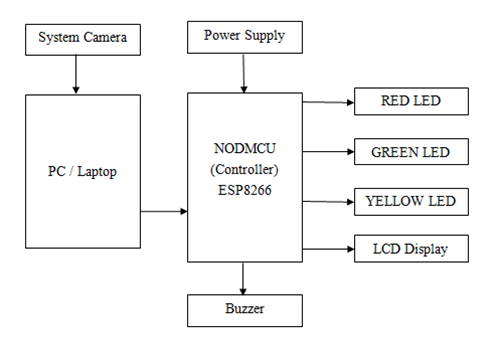DENSITY BASED TRAFFIC CONTROL USING IOT AND IMAGE PROCESSING
DENSITY BASED TRAFFIC CONTROL USING IOT AND IMAGE PROCESSING
Price : 10000
DENSITY BASED TRAFFIC CONTROL USING IOT AND IMAGE PROCESSING
Price : 10000
.svg)
ABSTRACT
With the rapid development of road infrastructure around the world, the volume of the vehicle on the road network increases which leads to traffic Congestion. The exact situation exists in major Indian cities. Traffic congestions are amongst the top list of the problems faced in India. This is mainly caused due to the rapid surprise in the number of vehicles in a short period. To overcome such an impact of traffic congestions, it is required to develop an IoT Based traffic control system. The proposed system would be based on the measurement of the actual traffic density on the road. This would be achieved using real-time video and image processing techniques. Wherein the images captured and are stored in the server, which will be compared with the real-time image captured via camera to identify the density. The theme is to control the traffic by determining the traffic density on each side of the four roads and enabling a controlling option of the traffic signal to the user through a software application.
INTRODUCTION
Increase in the number of population in major and metropolitan cities is leading to the rapid usage of vehicles, and therefore increasing the traffic level in different areas. Road congestion is the main cause for slower speed, longer waiting time, accidents and frustration. Therefore, to help to overcome such issues, we propose the initiation of Density-based Traffic Light using NODMCU to reduce traffic through signal control. One major cause identified is traffic congestion. The traffic congestion trend needs to be monitored closely to ensure the development of infrastructure is carried out effectively. In addition to that, traffic congestion has been associated with longer waiting times, delays in travel time and may cause traffic violations. The routine Traffic light signals are set at certain timing and are not able to recognize road density. With the development of technology, the systems are turning smarts and more intelligent. The possibilities of remote controlling and monitoring are not a difficult task compared to a couple of years back. With the faster internet connectivity, the advanced systems are developed to transmit data at a very high speed. This communication has acted as a backbone for some breath-taking technological development which was released in the market. This project allows being one of the possible solutions to overcome such problem of traffic congestion, by utilizing NODMCU with Image processing capability. We start by review of the literature. Based on this we develop a system using IoT to monitor and control traffic signal based on density using image processing. The system is implemented and simulated for monitoring traffic density, auto signalling mode, and a manual signalling mode.
BLOCK DIAGRAM

SYSTEM REQUIREMENTS
A. Hardware Requirements:
1. Power supply
2. NODMCU ESP8266 Microcontroller
3. Buzzer
4. 16x2 LCD Display
5. LED lights (Green, Red and Yellow)
B. Software Requirements:
1. Embedded C
2. Arduino IDE
CONCLUSION
The proposed method is focused on overcoming the traffic congestion scenarios experienced. The system would primarily focus on the image captured using the camera. The captured image would be cross-verified with a preset image loaded in the server to identify the density. Based on the density, the traffic movements are the trigger for the junctions. This reduces the overall waiting time and results in smoother traffic flow. The system would function automatically based on the collection of density images send from the location to the server. Future Recommendation: Many upgrades on the system are foreseen with more customization that could be adapted for various applications where remote monitoring and controlling is required. The system can have more integration like incident detection and failure notification etc. With the development of advanced technology, the platform can be used to integrate various devices like parking machines, Variable Message Signs, Traffic Count Stations, and City Surveillance Cameras, etc. Giving better control and monitoring on various devices remotely. This would lead the city to have an infrastructure which is smart, and technology-driven.